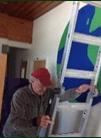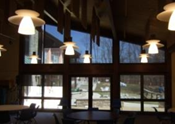Energy Conservation
The first steps to reducing our impact on the earth were to reduce the energy use by programing thermostats so we only heat and air condition spaces when they are in use, and by weatherizing the building to reduce loss of conditioned air by sealing gaps and insulating roofs and walls.
No-cost energy conservation: Thermostat Setbacks
After the last renovation there were nine different heat/cooling (HVAC) zones, allowing us to only heat or cool those being occupied at any given time. When spaces are empty thermostats are programmed to 55°F in the winter and 82°F in the summer, except in zones that have heat pumps, which we program to slowly raise or lower the temperature before a space is planned to be occupied.

Low-cost energy conservation measures
Volunteers cut openings to improve air flow, insulated the attic hatches, replaced weather stripping on old doors, and caulked around recessed ceiling lights to reduce heat loss.

Investments for future energy savings
Thanks to funds from our 2011 Green Spaces Initiative, we installed new low-e double-pane windows and doors in Fellowship Hall and the library. Solar shades further reduced heat gain.
Our Building's Heating and Cooling Zones
Click here to view the PDF of Our Building's Heating and Cooling Zones.
As the congregation grew over the years, what began as a two story 3000 sq.ft. building in 1970 expanded several times to over 17,600 sq.ft., adding equipment to heat and cool each additional area or “zone.” Since 2016 three of the nine original gas furnaces have been replaced with efficient electric heat pumps.

To help reduce the need to heat or cool a zone, staff can help you schedule meetings that take HVAC zones into account.
In rooms with a thermostat, please use the checklist by the light switch to return the room to the recommended setting!